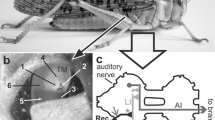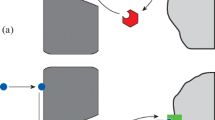Summary
-
1.
Ventrally located cold sensilla on the antennae of male adult Periplaneta americana are ring-shaped structures about 8 μ in diameter with a short hair emerging from their center (Figs. 1, 2).
-
2.
Further experiments (cf. Loftus, 1966) have substantiated the exclusion of the motion of air streams (2.5 m/sec) as a stimulus. The list of pure and mixed chemicals has been extended. The results of all tests including the odor of crushed abdomens of virginal female cockroaches were negative.
-
3.
Extracellularly recorded impulses which were either monophasic negative or diphasic at higher temperatures often became either diphasic or monophasic positive at lower temperatures. The effect was reversible (Fig. 4).
-
4.
When peak frequency is driven over 200 imp/sec, the time course of instantaneous frequency, F=f(t), plotted on double log scale displays 3 linear phases: 1 rising and 2 falling, followed by a fourth phase of recovery. At lower peak frequency only one falling phase develops. Before the onset of the recovery phase instantaneous frequency values determined from single impulse intervals lie within ±20% of a linear function on double log scale (Figs. 6, 7, 8).
-
5.
Instantaneous frequency values, even when formed from groups of as many as 10 successive impulse intervals, cease to convey unambiguous information on stimulus magnitude within about 300 msec after peak frequency (Figs. 9, 10).
-
6.
The reciprocal of the total number of impulses from stimulus onset up to about 800 msec afterwards (mean frequency), shows a much more precise relationship to ({ΔT) than instantaneous frequencies after F max do (Figs. 12, 13).
-
7.
When instantaneous frequency is plotted against temperature drop, the slope of the curves, F=f({ΔT), falls off with increasing ({ΔT) and time since stimulus onset. Thus the sensitivity of peak frequency is the highest of all instantaneous frequencies and itself higher at smaller temperature drops. An average receptor attains a sensitivity of -155 imp/sec/°C (Fig. 11).
-
8.
When peak frequency is plotted against initial temperature and temperature drop, a bulging surface develops. Hence a given peak frequency determines only a set of values for initial temperature and temperature drop. Three receptors with different characteristic surfaces should permit both components to be distinguished quantitatively (Fig. 14).
-
9.
As shown in peak frequency, the receptor's sensitivity to temperature drop diminishes, whereas the effect of initial temperature on peak frequency rises, towards the extremes of the temperature range investigated (Fig. 15).
-
10.
Treatment of 13 receptors and 280 responses indicate sufficient reliability of peak frequency response to permit discrimination of 7 to 17 discrete temperature drops between ({ΔT)=0.2° and ({ΔT) = 5.5° C (Fig. 16).
-
11.
A second identical short temperature drop repeated after 1.5 sec rewarniing evokes a peak frequency on the average 15% lower than the first. This effect could diminish resolving power severely (Fig. 17).
-
12.
The longest single impulse intervals occur at rapid temperature rises. Reckoned as frequencies they attain values in the order of 0.1 imp/sec. These frequency minima show good quantitative relationship to the extent of temperature rise and indicate the possibility of this cold receptor's providing the CNS with information on warming (Fig. 18).
-
13.
Some receptors show a sharp activity maximum between 17° and 37° C in response to steady temperature. The responses (mean frequencies) of many receptors, however, manifest variation up to and beyond 20% of the frequency range corresponding to steady temperature between 17° and 37° C. Hence the receptor is a poor thermometer (Figs. 19, 20, 21).
-
14.
Taken absolutely the sensitivity of Periplaneta's cold receptor to temperature change (-155 imp/sec/°C) seems second only to infrared sensitive crotalid facial pits (+500 imp/sec/°C).
Similar content being viewed by others
References
Barth, F. G.: Ein einzelnes Spaltsinnesorgan auf dem Spinnentarsus: seine Erregung in Abhängigkeit von den Parametern des Luftschallreizes. Z. vergl. Physiol. 55, 407–449 (1967).
Boeckh, J.: Elektrophysiologische Untersuchungen an einzelnen Geruchsrezeptoren auf den Antennen des Totengräbers (Necrophorus, Coleoptera). Z. vergl. Physiol. 46, 212–248 (1962).
Bullock, T. H., and F. P. J. Diecke: Properties of an infra-red receptor. J. Physiol. (Lond.) 134, 47–87 (1956).
Burkhardt, D.: Die Erregungsvorgänge sensibler Ganglienzellen in Abhängigkeit von der Temperatur. Biol. Zbl. 78, 22–62 (1959).
Goris, R. C., and M. Nomoto: Infrared reception in oriental Crotaline snakes. Comp. Biochem. Physiol. 23, 879–892 (1967).
Hensel, H.: Afferente Impulse aus den Kältereceptoren der äußeren Haut. Pflügers Arch. ges. Physiol. 256, 195–211 (1952a).
—: Physiologie der Thermoreception. Ergebn. Physiol. 47, 166–368 (1952b).
—: Quantitative Beziehungen zwischen Temperaturreiz und Aktionspotentialen der Lorenzinischen Ampullen. Z. vergl. Physiol. 87, 509–526 (1955).
Hensel, H., A. Iggo, and I. Witt: A quantitative survey of sensitive cutaneous thermoreceptors with C afferent fibres. J. Physiol. (Lond.) 153, 113–126 (1960).
—, L. Ström, and Y. Zotterman: Electrophysiological measurements of depth of thermoreceptors. J. Neurophysiol. 14, 423–429 (1951).
—, u. Y. Zotterman: Quantitative Beziehungen zwischen der Entladung einzelner Kältefasern und der Temperatur. Acta physiol. scand. 23, 291–319 (1951).
Heran, H.: Untersuchungen über den Temperatursinn der Honigbiene (Apis mellifica) unter besonderer Berücksichtigung der Wahrnehmung strahlender Wärme. Z. vergl. Physiol. 34, 179–206 (1952).
Herter, K.: Der Temperatursinn der Insekten. Berlin: Dunker & Humblot 1953.
Hodgson, E. S., and K. D. Roeder: Electrophysiological studies of arthropod chemoreception. I. General properties of the labellar chemoreceptors of Diptera. J. cell. comp. Physiol. 48, 51–75 (1956).
Hoffmann, C.: Vergleichende Physiologie des Temperatursinnes und der chemischen Sinne. Fortsch. Zool. 13, 190–256 (1961).
Kerkut, G. A., and B. J. R. Taylor: A temperature receptor in the tarsus of the cockroach, Periplaneta americana. J. exp. Biol. 34, 486–493 (1957).
—: The effect of temperature changes on the activity of poikilotherms. Behaviour 13, 259–279 (1958).
Lacher, V.: Elektrophysiologische Untersuchungen an einzelnen Rezeptoren für Geruch, Kohlendioxyd, Luftfeuchtigkeit und Temperatur auf den Antennen der Arbeitsbiene und der Drohne (Apis mellifica L.). Z. vergl. Physiol. 48, 587–623 (1964).
Larimer, J. L.: The effects of temperature on the activity of the caudal photoreceptor. Comp. Biochem. Physiol. 22, 683–700 (1967).
Loftus, R.: Cold receptor on the antenna of Periplaneta americana. Z. vergl. Physiol. 52, 380–385 (1966).
Murray, R.W.: The response of the ampullae of Lorenzini to combined stimulation by temperature change and weak direct currents. J. Physiol. (Lond.) 145, 1–13 (1959).
—: The response of the ampullae of Lorenzini of elasmobranchs to mechanical stimulation. J. exp. Biol. 37, 417–424 (1960).
—: The response of the ampullae of Lorenzini of elasmobranchs to electrical stimulation. J. exp. Biol. 39, 119–128 (1962a).
—: Temperature receptors. Advanc. comp. Physiol. Biochem. 1, 117–175 (1962b).
—: Temperature receptors in animals. Symp. Soc. exp. Biol. 16, 245–266 (1962c).
Pierau, F.-K., u. H. D. Meissner: Die Temperaturempfindlichkeit isolierter Lorenzinischer Ampullen. Helgoländer wiss. Meeresunters. 14, 381–391 (1966).
Sand, A.: The function of the ampullae of Lorenzini, with some observations on the effect of temperature on sensory rhythms. Proc. roy. Soc. B 125, 524–553 (1938).
Schoonhoven, L. M.: Some cold receptors in larvae of three lepidoptera species. J. Insect Physiol. 13, 821–826 (1967).
—, and V. G. Dethier: Sensory aspects of host-plant discrimination by lepidopterous larvae. Arch. néerl. Zool. 16, 497–530 (1966).
Späth, M.: Die Wirkung der Temperatur auf die Mechanoreceptoren des Knochenfisches Leuciscus rutilis L. Z. vergl. Physiol. 56, 431–462 (1967).
Thurm, U.: Die Beziehung zwischen mechanischen Reizgrößen und stationären Erregungszuständen bei Borstenfeld-Sensillen von Bienen. Z. vergl. Physiol. 46, 351–382 (1963).
Author information
Authors and Affiliations
Rights and permissions
About this article
Cite this article
Loftus, R. The response of the antennal cold receptor of Periplaneta americana to rapid temperature changes and to steady temperature. Zeitschrift für vergleichende Physiologie 59, 413–455 (1968). https://doi.org/10.1007/BF00365971
Received:
Issue Date:
DOI: https://doi.org/10.1007/BF00365971




